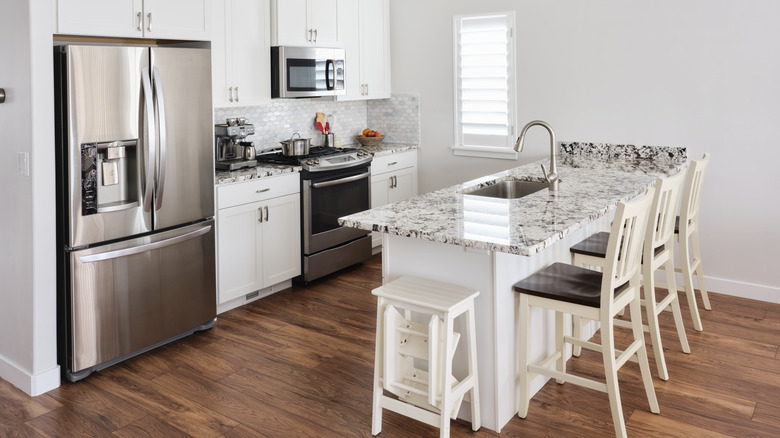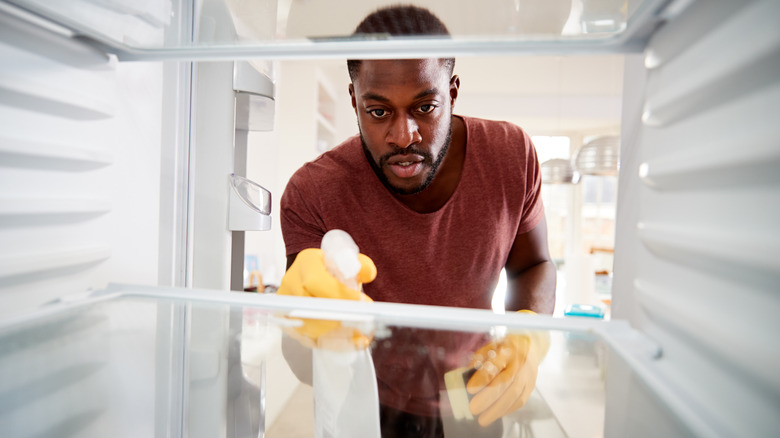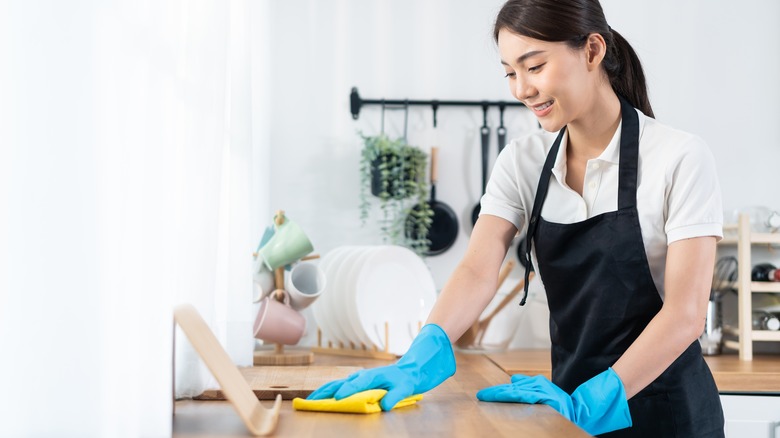Our Cleaning Expert Shares The Five Best Hacks For A Spotless Kitchen
As one of the most frequently used areas in your home, your kitchen sees a lot of action — and a lot of messes. But between work, kids, and a mountain of other household chores to catch up on, it can feel challenging trying to figure out how to best clean your kitchen. To figure out a solution to this conundrum, House Digest spoke exclusively with Katie Dills, Brand President of The Cleaning Authority, about the five best hacks you can employ in order to get and maintain a spotless kitchen. From eliminating smells by targeting the garbage and fridge to tackling the drawers, sinks, and counter surfaces, we've got the inside scoop on how to stay on top of the mess.
The best part about these tips? You most likely already have all of the cleaning ingredients at the ready. Even if it seems like your kitchen is a disaster, Dills says not to worry, as these tasks "can be done as quickly or spread out as your time allows."
Eliminate smells by cleaning the garbage and refrigerator
The first two hacks for a spotless kitchen involve tackling smells. First, from your garbage, and second, from your refrigerator. Katie Dills exclusively told House Digest that cleaning your garbage can is a must in order to eliminate any smells that may be lingering. While regularly taking the trash out is a given, Dills explains that this isn't always enough. "Trash cans can harbor odors, liquids, and residue from your trash," she points out.
Fortunately, there's an easy way to clean your garbage can using vinegar, dish soap, and water. "While the can is empty, mix 2 cups of vinegar, 1 tablespoon of dish soap, and water into a spray bottle and spray both the interior and exterior of the can. For any caked-on food, you may need to use a scrub brush," Dills tells us. You can then use some water to rinse off any remaining residue and then dry with a cloth or paper towel.
Next up is the refrigerator. After clearing out the food and any removable compartments and shelving, you'll need to grab baking soda. "Clean the inside of the fridge with a solution of 2 tablespoons baking soda and 1 quart hot water. Rinse with a damp cloth, then dry with a towel," Dills explains, adding that you can also soak any bins or shelving in the baking soda solution as well.
Tackling drawers, surfaces, sinks, and sponges
Now that you've addressed the garbage and sink, it's time to move on to the last three hacks: cleaning drawers, wiping sinks and surfaces, and sanitizing sponges. Drawers and cabinets can collect crumbs, but, as Katie Dills exclusively explained to House Digest, you can use a handheld vacuum or lint roller for easy removal. After clearing the cabinets and vacuuming them, wipe the surfaces with warm water and soap, drying with a separate cloth.
For sinks and countertops, Dills says that baking soda and dish soap can go a long way. "We recommend a mixture of 3 tablespoons baking soda, 1 tablespoon dish soap, and ¼ cup warm water. You can also sprinkle a little baking soda onto a damp soft cloth and buff out the sink for stainless steel surfaces." When wiping surfaces, use a clean cloth or paper towel to keep your counters germ-free.
Finally, Dills gives some tips for sterilizing sponges. Beyond replacing your sponges every two weeks, you can employ daily sanitation methods to ensure you are using them in the safest way possible. First, you can simply soak your sponge in vinegar for 5 minutes. There's also the microwave method. Put a damp sponge in the microwave for 1 minute, taking care that it doesn't burn. The dishwasher is helpful for sanitizing as well. "Place the sponge on the top rack, put your dishwasher on the "heated dry" setting, and take out the sponge when the dishwasher cycle is over," Dills explains.


